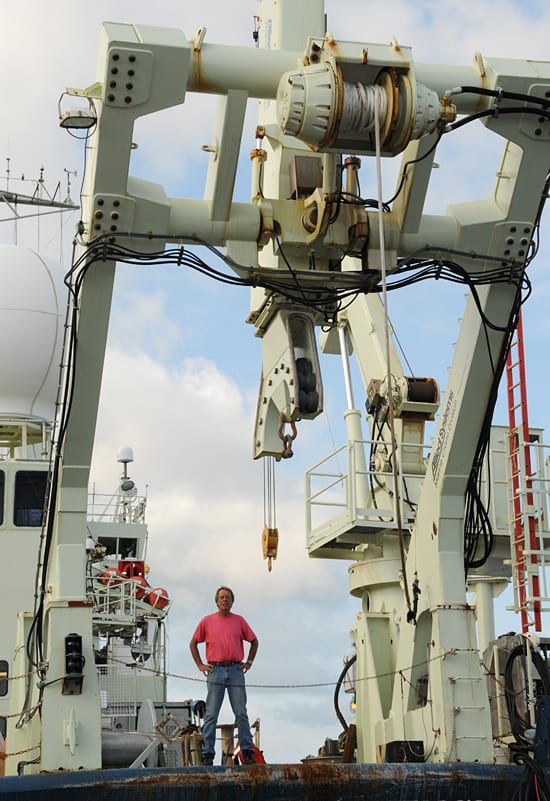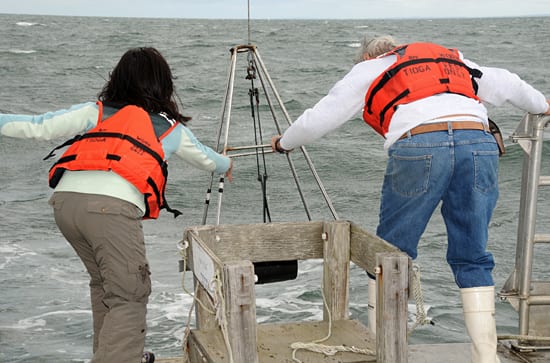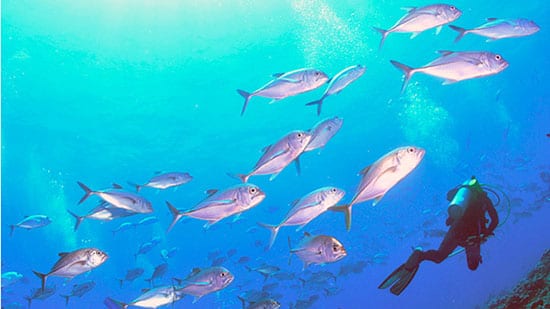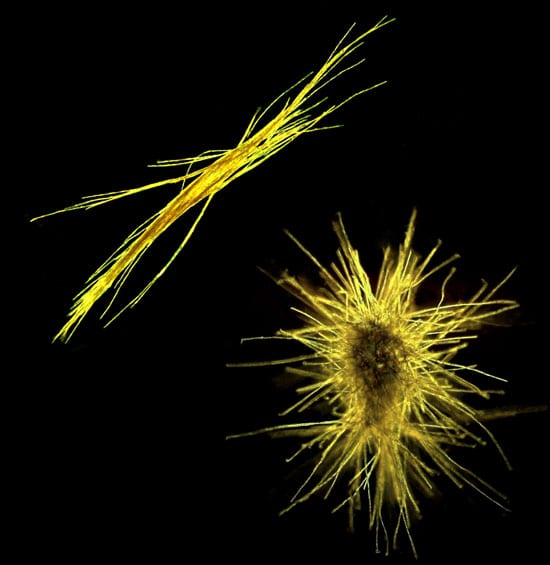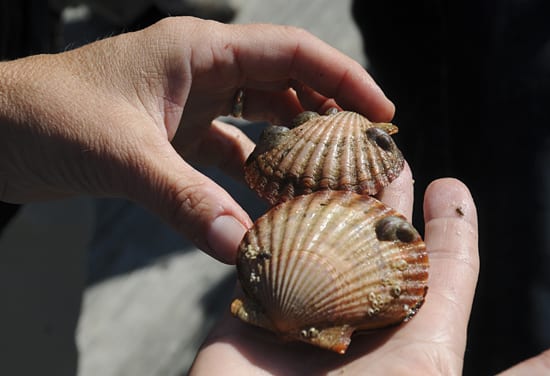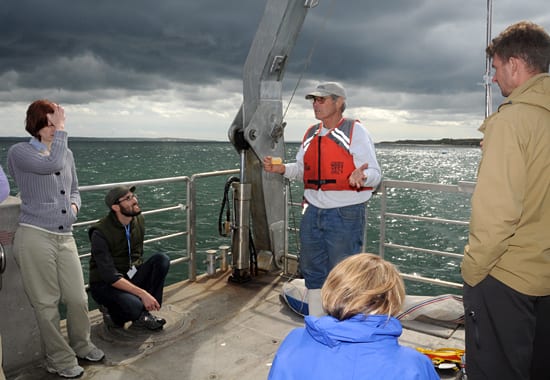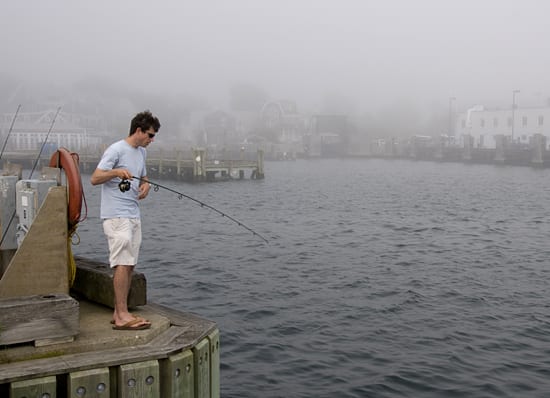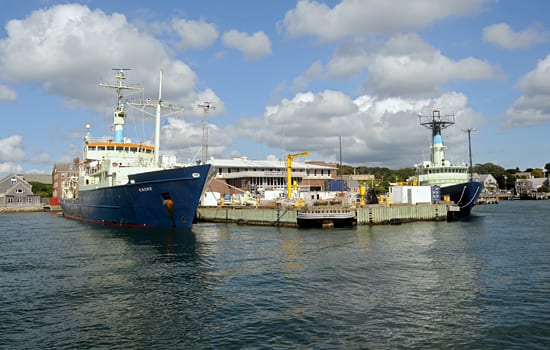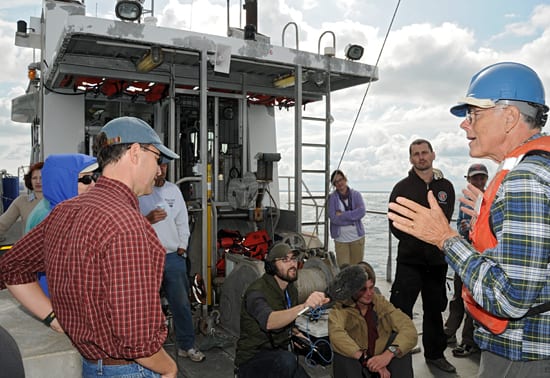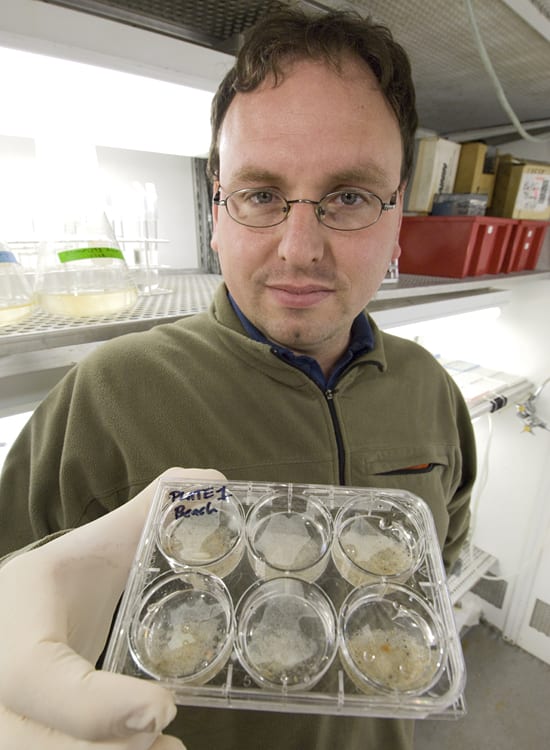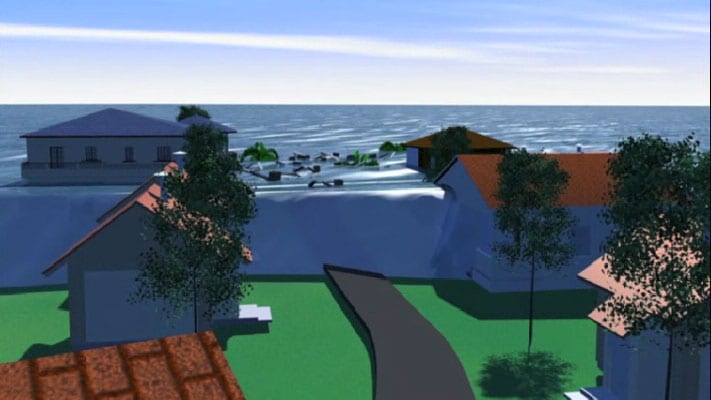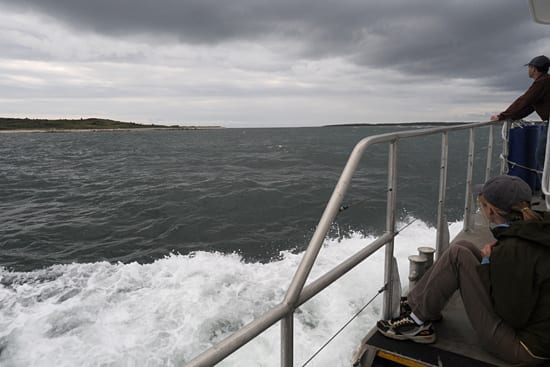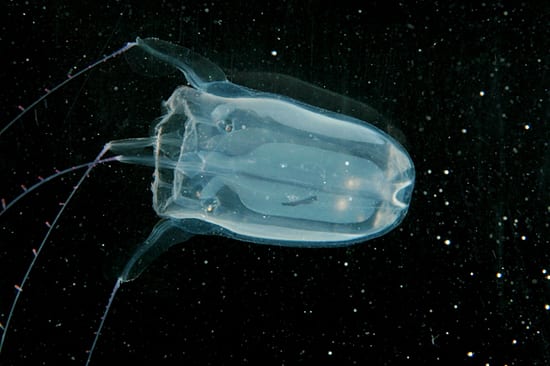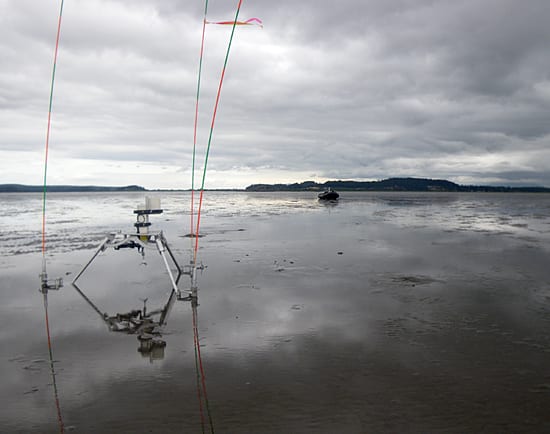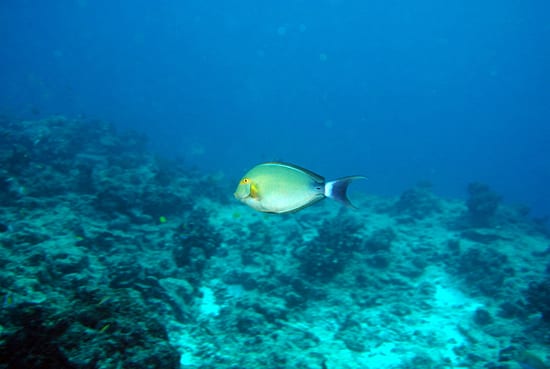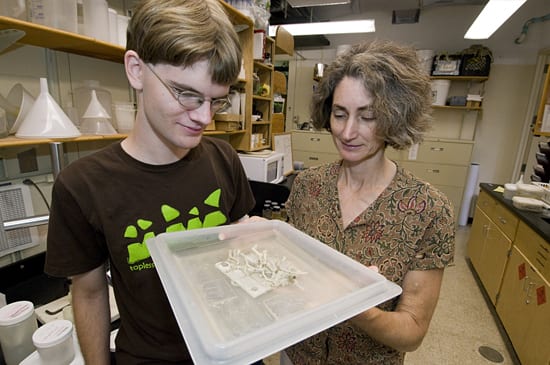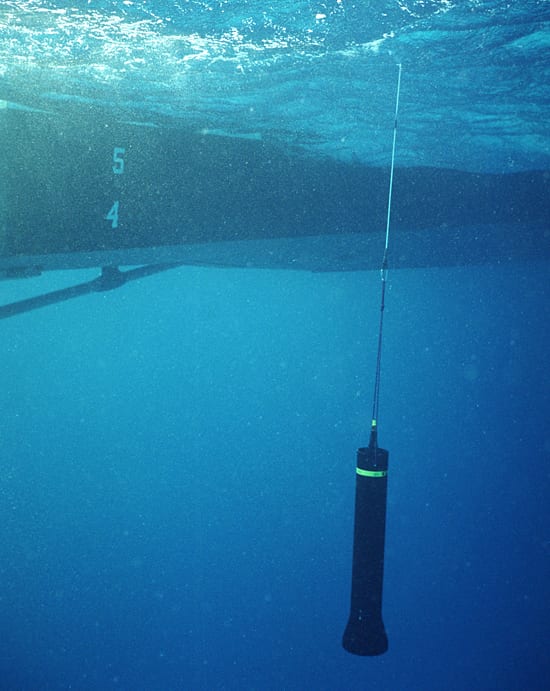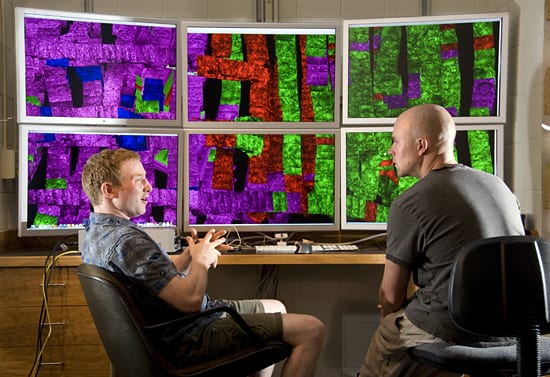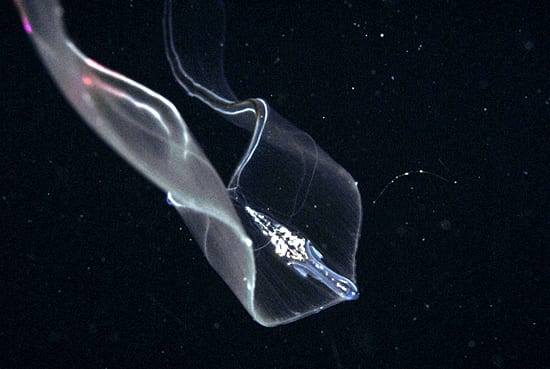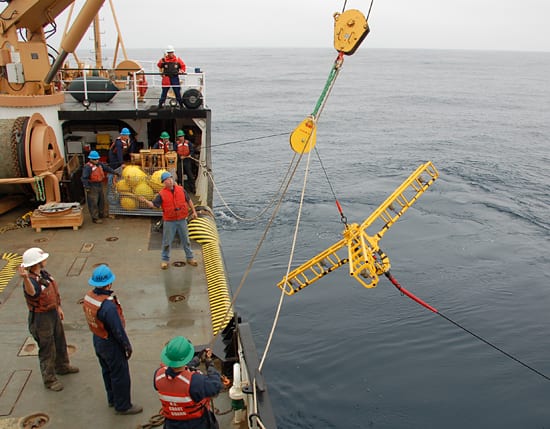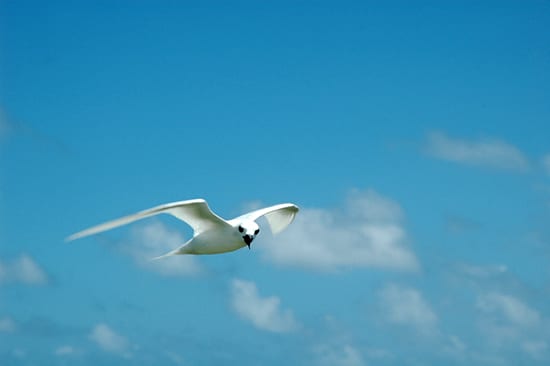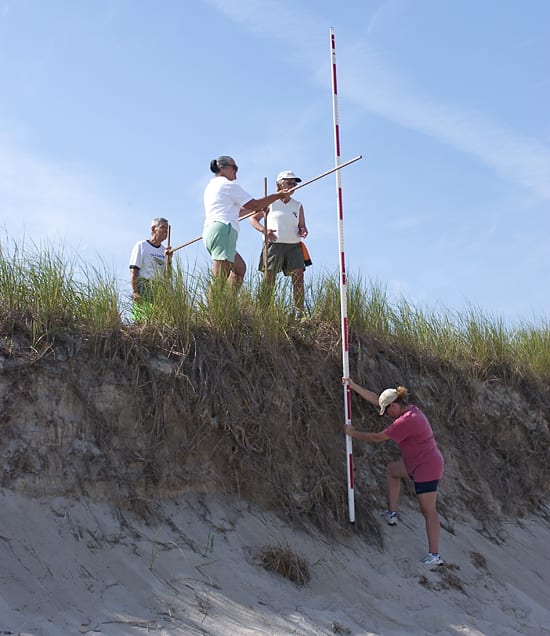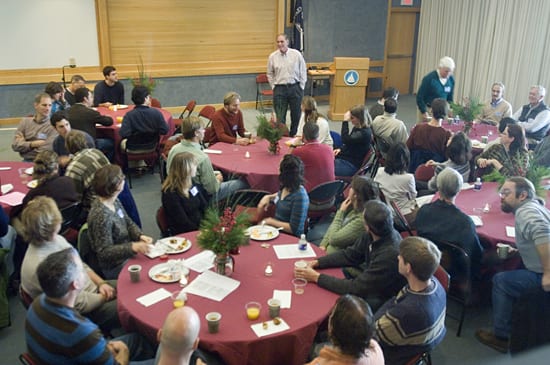Multimedia Items
Longing to go, again
Senior research specialist Jim Broda stands under the long core deployment mechanism on R/V Knorr as the ship sits at the WHOI dock in September 2009. The long corer, which…
Read MorePress box
Ocean Science Journalism Fellow Jane Qiu helps oceanographer emeritus and biologist George Hampson deploy a Van Veen Grab Sampler off the fantail of R/V Tioga during a day cruise in…
Read MoreVoyage to the Remote Phoenix Islands
Microbe mystery solved
Trichodesmium, shown in this micrograph, is a photosynthetic bacteria, common in warm, tropical and subtropical surface waters. Trichodesmium cells form filaments called trichomes that associate into the roughly 2mm colonies…
Read MoreListening to bacteria
Summer Student Fellow Rose Kantor spent her summer working with marine chemist Tracy Mincer studying quorum sensing in microbes associated with sinking particles in the ocean water column. Quorum sensing…
Read MoreChanging chemistry
Ocean acidification—a consequence of increased carbon dioxide emissions from human industrial activity—could harm a wide range of marine organisms and the food webs that depend on them. Mollusks, including oysters,…
Read MoreUnder threatening skies
Oceanographer Emeritus George Hampson (center) shows a group of Ocean Science Journalism Fellows how to take water samples during a cruise on the R/V Tioga in September 2009. Though officially…
Read MoreFishing for research
Summer Student Fellow William Goldsmith fishes for research off the Iselin dock this past summer. Goldsmith, of Harvard University, worked in WHOI’s Fish Ecology Lab alongside biologist Simon Thorrold. The…
Read MoreA rare sight
It doesn’t happen often, but on this sunny September day, two of the Institution’s research vessels — Knorr and Oceanus — were in port at the Iselin Marine Facility. Where…
Read MoreCurrent news
WHOI scientist emeritus Sandy Williams describes the Modular Acoustic Velocity Sensor (MAVS) to the 2009 class of WHOI Ocean Science Journalism Fellows. Williams and physical oceanographer Jim Churchill led the…
Read MoreHunt for Microbial ‘Trojan Horses’
Matt First, a postdoctoral scholar in the WHOI Geology and Geophysics Department, studies “Trojan horses” in the sea — single-celled animals that harbor disease-causing bacteria inside them. “These protists don’t…
Read MoreAnatomy of a Tsunami
While tsunamis can neither be prevented nor precisely predicted, people educated about particular warning signs can save their own lives and the lives of others. Learn more about tsunamis and…
Read MoreNot so friendly skies
2009 Ocean Science Journalism fellows Elise Hugus and Jeff Rubin gaze out at threatening skies as the research vessel Tioga heads into the Quick’s Hole passage on its way back…
Read MoreBeware the box-jelly
This jellyfish is called a box-jelly, or a cubomedusa. This type of jellyfish can deliver toxic stings, so it was collected very carefully by a researchers working in the Phoenix…
Read MoreWhat makes a tidal flat tick?
That’s exactly what WHOI researchers are working to find out with the Skagit Tidal Flats Experiment. Instrument tripods deployed in Skagit Bay are being used to determine the importance of…
Read MoreGliding surgeon
A surgeon fish glides by a coral reef in the Phoenix Islands Protected Area. A period of very warm water in the equatorial Pacific in 2002, brought about by an…
Read MoreFrom one Summer Student Fellow to another
Summer Student Fellow (SSF) Gar Secrist (left), an ecological biologist, examines tubeworms or Tevnia jerichonana alongside WHOI biologist Lauren Mullineaux, who was also an SSF as an undergraduate. Her laboratory…
Read MoreMeasuring ocean light
Developed by WHOI engineer Paul Fucile, this inexpensive, easy-to-deploy bathy-photometer measures light levels from bioluminescent marine life. Marine organisms ranging from bacteria to fish make their own chemically induced light—called…
Read MorePieces of the puzzle
Summer Student Fellow Garrett Mitchell, of the University of Maryland at College Park, spent his summer working with WHOI geologist Adam Soule. The two used seafloor imagery collected by Autonomous…
Read MoreVenus’ girdle
Looping through the open ocean, this ribbon-shaped jelly-like animal, called a “Venus’ girdle” comb jelly, catches food with a sticky substance. This one was seen in the ocean off the…
Read MoreMoorings and buoys
One of the unsung heroes of oceanography is mooring operations. Currents are ceaselessly moving, plankton constantly bloom, marine traffic is continuously monitored, the sea floor is continually being built—all of…
Read MoreEyes to the skies
A fairy tern glances at the camera at the right instant, in the skies of McKean Island, one of the Phoenix Islands. The Phoenix Islands Protected Area, of the nation…
Read MoreWhere land and sea meet
In 2003 the Woods Hole Sea Grant worked with a group of volunteers who performed beach profile surveys at Cold Storage Beach, East Dennis, MA to assess how the beach…
Read MoreThree Cheers for Postdocs!
Today marks the first annual “National Postdoc Appreciation Day” to celebrate the significant contribution that postdocs make to the U.S. scientific endeavor. What’s a “postdoc?” Few non-scientists are aware of…
Read More
